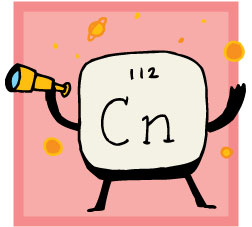Blogging the Periodic Table

For scientists who discover a new element, beating their peers is only part of the fun. The real thrill comes in selecting the element's name. Sure, other scientists get to name their discoveries, too, like new salamanders or craters on Mars. But a new element gets its own box on the periodic table—the most iconic real estate in science, and something that will hang in every science classroom in the world. Forever.
The latest element to be named was No. 112. It got its name last summer, when a tribunal of chemists ruled that a German team had provided enough evidence to confirm its existence. (The approval process took 13 years.) In selecting the name, the Germans had only a few rules to abide by. The name couldn't have been submitted before as a name for any other potential element. The name had to end in –ium. And the team couldn't name it after a living person (a rule some Americans brazenly violated in the 1990s by naming Element 106, seaborgium, after the then-still-breathing Glenn Seaborg). Beyond that, the Germans could name Element 112 whatever suited them.
That said, strong trends have emerged in the naming of elements since the 1950s, and scientists are as susceptible to tradition as anyone. Scientists used to name lots of elements after mythological creatures—like thorium, named after Thor, or tantalum, after Tantalus, or helium, after Helios, the sun god. They also liked astronomical references, as in the trio uranium, neptunium, and plutonium. But no one has named an element for anything mythological or celestial since promethium and plutonium in the 1940s.
Scientists also used to pick simple descriptive names. Noble gases like xenon and krypton, which are colorless and odorless, got names that meant elusive or hidden in Greek. * (I'll explain why Greek was trendy in a later post.) For various reasons, the elements beryllium, chlorine, praseodymium, and thallium are all named after words for "green." But this trend, too, has fallen out of favor.
The most enduring fashion for naming elements (predating even the table itself) is blatant nationalism, a trend that has gotten ugly a few times. Three German chemists in the 1920s discovered two prospective elements and named them rhenium, after the Rhine River, and masurium, after the state of Masuria—both sites of German victories during World War I. This didn't exactly endear the three to their European colleagues. Partly out of pique, other scientists attacked and dismantled the claim for masurium, Element 43, arguing first that the traces of "masurium" in samples were actually contamination from known elements, and, second, that the trio could not have found as much masurium as they claimed anyway. In the end, Element 43 was declared undiscovered once again. (Another scientist, an Italian Jew, discovered Element 43 for real in 1937. One of the German chemists—decked out in a quasi-military uniform covered in swastikas—flew to Italy in an unsuccessful attempt to bully the Italian into dropping his claim.)
There was a decent chance the German team that discovered Element 112 would name it after some local land as well. After all, the team, based in the city of Darmstadt, in the German state of Hesse, had already named two elements they discovered in the 1990s darmstadtium and hassium. (Germanium was taken.)
But in recent years, another trend has come to dominate the nomenclature of new elements—naming them after great scientists. No one had ever honored a scientist this way before the 1950s, but since then 11 of the 14 elements discovered and named (from einsteinium, Element 99, on) do just that. Most of these names still shaded patriotic and honor a local son or daughter, but not always. An American team led by the aforementioned Glenn Seaborg named Element 101 mendelevium, after Dmitri Mendeleev, the scientist generally given credit for developing the periodic table. Mendeleev was Russian, so this was a daring gesture during the Cold War.
In the end, the Germans looked beyond their national borders as well, though not far. They settled on copernicium, after Nicolaus Copernicus, the Polish Catholic priest and part-time astronomer who put the sun at the center of our solar system. This choice was unusual in some ways—Copernicus lived centuries before anyone knew what elements were, much less the periodic table. But in other ways, it was an inspired choice—utterly uncontroversial (as Werner Heisenberg might have been) and yet a scientific hero, a name people would recognize. For better or worse, Western cultures tend to venerate individual geniuses, and while you can't quite say the German team succumbed to our modern celebrity culture, even the periodic table cannot entirely escape the fashions of its time.
Incidentally, you pronounce the name "co-per-nee-see-um," with a soft "c" toward the end, even though that's not how you pronounce Copernicus. There are two reasons. It's more fluid that way. And it also parallels the pronunciation of americium, Element 95, which was named after America by American scientists but is pronounced "am-er-ee-see-um." Precedent counts for a lot on the periodic table—its whole scientific basis is that elements act like the ones that came before them—and this love of precedence seems to extend to pronunciation as well.
Correction, July 13, 2010: The article originally stated that noble gases like xenon and krypton don't react with other atoms "and are therefore colorless and odorless." These gases are colorless and odorless but not because they don't react with other atoms. (Return to the corrected sentence.)